Art World
What Are Famous Artists Cooking Up Under Lockdown? Urs Fischer, Chloe Wise, and Others Share Their Deliciously Creative Recipes
Here's some Memorial Day cooking inspiration.
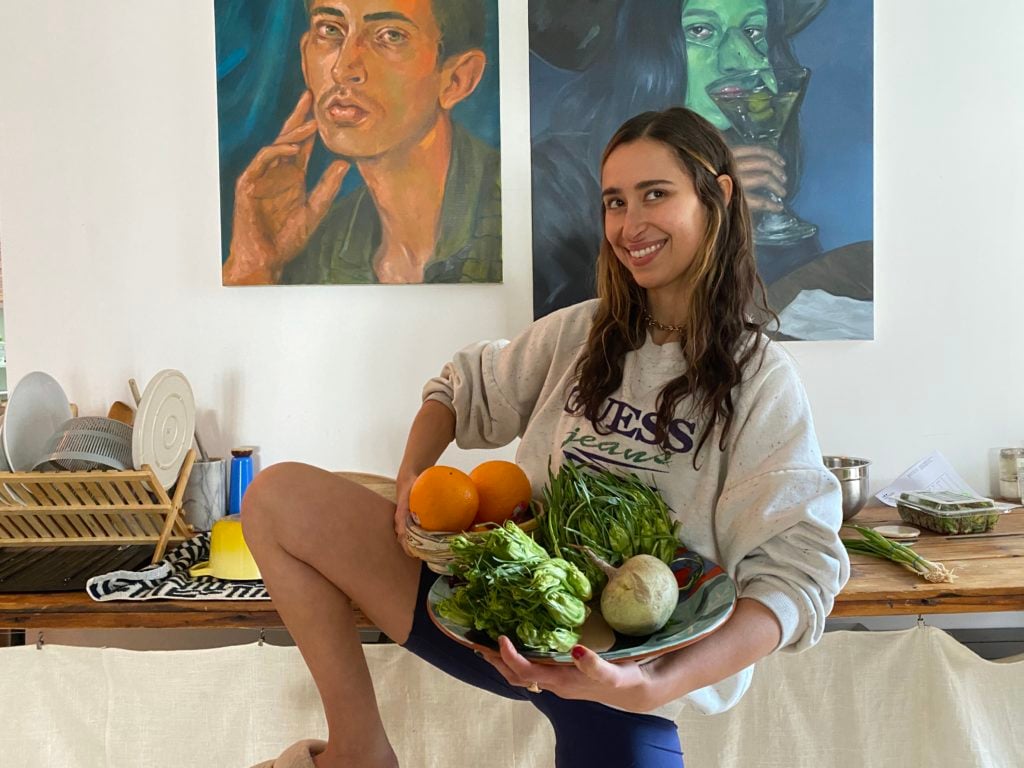
Here's some Memorial Day cooking inspiration.

Sarah Cascone

We’re all cooking a lot more than we used to, and Memorial Day cookouts give us even more of an excuse to get creative. This year, in search of a little culinary inspiration, we turned to artists who have worked with food in their practices, either as a material or subject matter, to ask them what they’ve been cooking during these unprecedented times.
Here are the dispatches they sent in from around the world in late March and early April on their favorite recipes, their strategies for stocking up, and advice for special diets.
Enjoy—and don’t forget to check out some of our previous posts on artists’ recipes here and here.
Urs Fischer’s food-related art includes a series of irreverent portraits overlaying ingredients—a banana, a hardboiled egg—atop his subject’s faces, obscuring their features. He also created a line of Louis Vuitton bags adorned with dangling sculptures of strawberries, apples, carrots, mushrooms, and other food items.
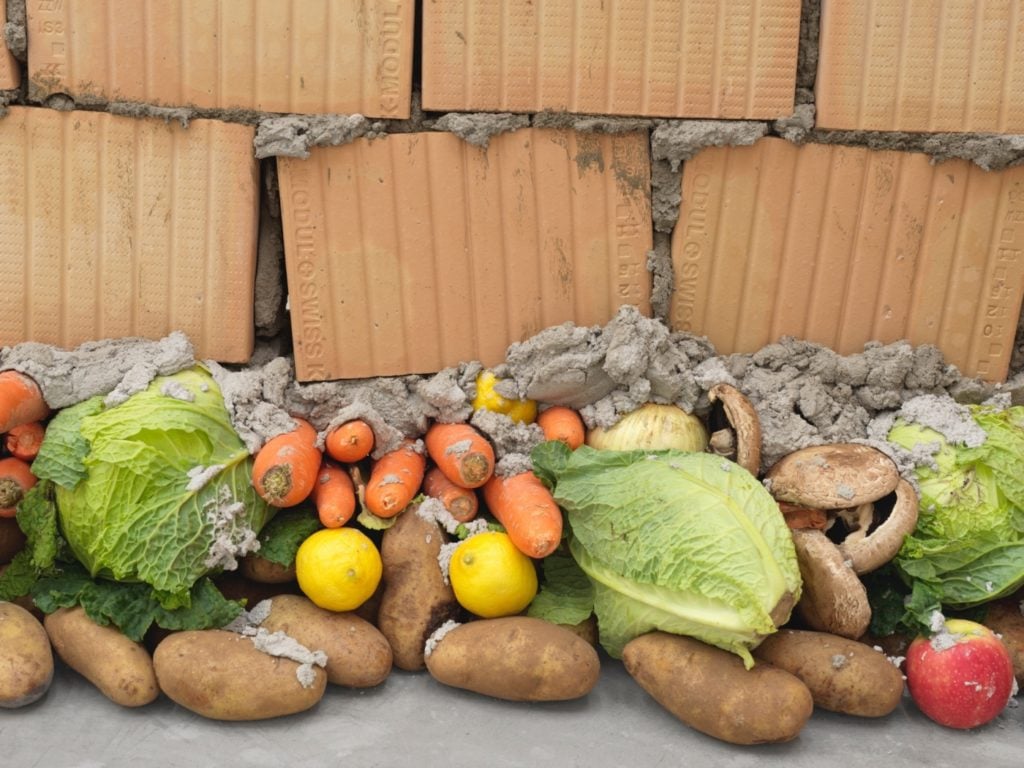
Urs Fischer, Faules Fundament (Rotten Foundation) (1998). Courtesy of the artist and Karma Gallery.
This is a recipe to celebrate one of those rare days when we get home from the supermarket with fresh produce in the bag.
Tofu Cucumber Salad
Ingredients:
½ pack firm tofu
1 cucumber
cilantro
hot pepper
sesame oil
amino acid & soy sauce (I personally like the coconut aminos)
toasted sesame seeds
Instructions:
Slice firm tofu into three or four slabs. To extract the water, press the slices between two kitchen towels until they feel dry.
Crumble up dried tofu by hand into a bowl until it looks like a crumbled feta cheese, and season with amino acids/soy sauce.
Beat the cucumber to make it a little softer. Half lengthwise and deseed. Cut the cucumber into little cubes. (I do them about three eighths of an inch.)
Put cucumber in a separate bowl and toss with sesame oil.
Combine seasoned tofu and the cucumber cubes with chopped cilantro, and, if you like, finely chopped and deseeded hot peppers.
Sprinkle toasted sesame seeds on top.
Jorge Pardo’s explorations of the intersection between art and design have resulted in his furniture-based sculptures, which include a functional dining room installation for the restaurant in Berlin’s Paul-Löbe Building, part of the art collection of the Deutscher Bundestag. During lockdown, he’s been filming a new series, “Cooking With Jorge Pardo,” for his New York gallery, Petzel. This summer, Pardo plans to open a bistro-style Yucatan-influenced restaurant, Hunik, in Merida with his business partner, chef Roberto Solis.
I’ve always cooked, even when I was a kid. My father used to cook and I used to cook with him and my mother cooked and I cooked with her. My mother used to be really good with desserts and I would always help her with recipes because they’re in English. My grandmother always cooked. I’ve always been involved in cooking. But I’ve discovered while I’m here, that I have to cook every freaking day—I’ve been enjoying it though. I don’t think I’ve cooked this consistently ever in my life, but I do love it.
About two weeks ago, I figured it might get kind of crazy so I went and stocked up on chicken, beef, and pork—not really fish, you have to buy the fish fresh. I bought a lot of pasta and bunch of things that I need for cooking and I just froze it all. I probably bought 50 pounds of protein and 20 pounds of pasta, 12 bottles of tequila and 20 bottles of prosecco and stuff like that. I bought three pounds of chocolate from my favorite chocolatier here in Merida, ki’ Xocolatl. And I got three gallons of aloe vera gel and a couple of gallons of alcohol for a homemade sanitizer. I am now having masks made by my local tailor using leftover fabric from the clothes that he makes for me.
Tongue with Polenta and Zucchini Squash
Ingredients:
1 tongue
1 onion
2 tbsp fish sauce
1 can sardines
2 bottles cheap white wine
6 cloves garlic
1 tbsp fermented Korean chili paste
a little bit of chili powder
1 tsp oregano
1 tsp cumin
salt and pepper to taste
Instructions:
Sauté all ingredients except tongue and wine in a pressure cooker until it smells great. Add tongue and brown.
Add wine to cover tongue by a half inch.
Turn pressure cooker on. Total cooking time is around an hour and a half, but you should open and check after 45 minutes. Add more wine if it needs to finish cooking for 30–45 minutes.
Once tongue is cooked, take tongue out, peel creepy skin off, and cut into desired chunks. It should be very soft and yummy.
Take liquid out of the pressure cooker and strain. Then put the liquid in a sauce pan and reduce. Add tongue until it starts to caramelize a bit, and serve over polenta.
Polenta is simple to cook. It should take about a half hour in total. The ratio is four to five cups of water to one cup of polenta.
Bring water to a boil in a medium-size heavy sauce pan.
Pour cornmeal slowly into the water, stirring with a wire whisk or wooden spoon.
Continue stirring until creamy and soft. Add parmesan and butter to taste.
For her portrait series “The Supper Club,” highlighting contemporary artists of color, Elia Alba hosted 25 dinner parties, discussing political issues over a communal meal and then photographing guests such as Jeffrey Gibson, Hank Willis Thomas, and LaToya Ruby Frazier.
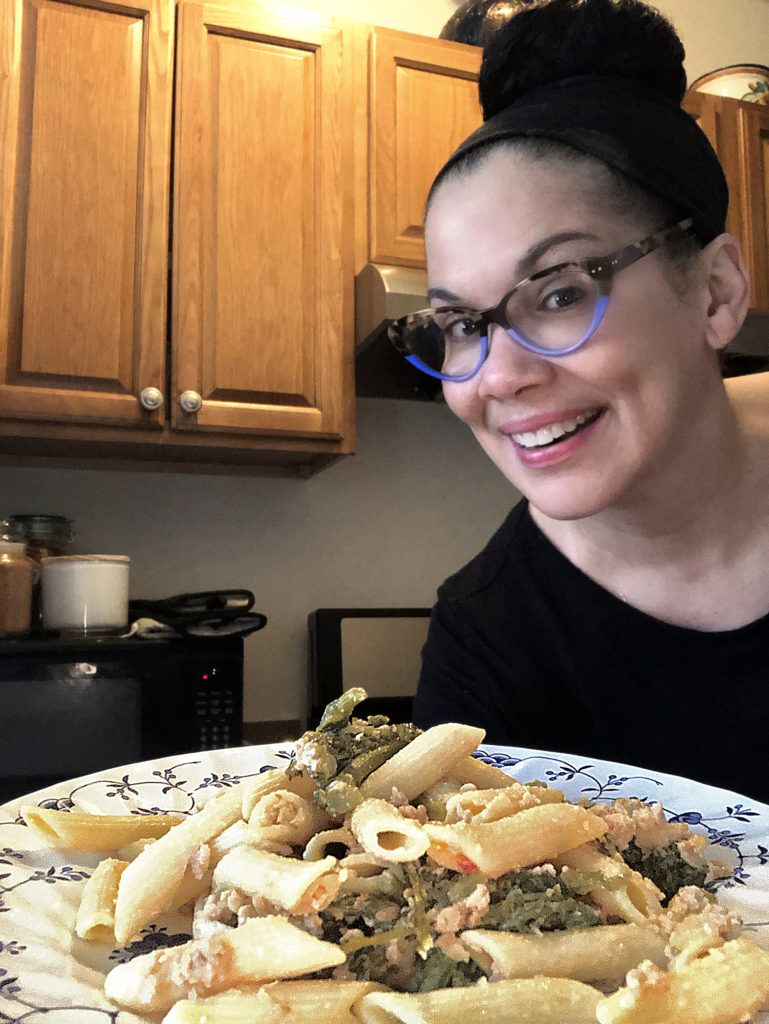
Elia Alba with her pasta with broccoli rabe and sausage. Photo by Elia Alba.
Cooking was very important to my mother. I think our lives revolved around food all the time. There were specific meals for holidays and birthdays, food as gifts and so on. My parents immigrated from the Dominican Republics in the 1950s. By the time I was six, we settled in the Bronx. At that time, it was a mixed neighborhood and our neighbors where predominately Italian, Jamaican, Germans, and Puerto Ricans.
I think it was at that time that my mother started to introduce Italian food into her menus. It was through her and our neighbors that I really learned to love Italian food, and looking back now, it was through food that two families were able to meet and commune.
It is no wonder that my recent art project revolved around food and community; I really learned this from my mother. In this time of isolation, contemplation, and reflection, I have been thinking of my childhood and the sense of caring and comfort that came out of the food our mother made for us.
Pasta with Broccoli Rabe and Sausage
Ingredients:
1 lb orecchiette or penne
1 tbsp olive oil
1 lb hot Italian or turkey sausage, casings removed
4 cloves garlic, finely chopped
2½ cups low-sodium chicken broth (water ok)
⅛ teaspoon crushed red pepper
1 bunch broccoli rabe (rapini)
4 tbsp butter, cut into pieces
1 cup grated Parmesan (4 oz)
¼ tsp kosher salt
¼ tsp black pepper
Instructions:
Cook the pasta according to the package directions. Drain and return it to the pot.
Heat the oil in a large saucepan over medium heat. Add the sausage and cook, breaking it up with a spoon, until it’s no longer pink, five to six minutes.
Stir in the garlic and cook one minute.
Add the broth and red pepper and bring to a boil. Add the broccoli rabe and simmer, covered, until tender, three to four minutes.
Stir in the butter and Parmesan and cook, uncovered, until the sauce thickens slightly, one to two minutes.
Toss the pasta with the sausage mixture and salt and pepper.
Mark Dion ran his own lemonade stand at the very first Armory Show, then called the Gramercy International Art Fair, back in 1994—a project he restaged for the fair’s 25th anniversary in 2019. Last year, his Conservatory for Confectionery Curiosities (2008/2019), a display of colorful desserts created with wife Dana Sherwood, was part of “Mark Dion: Follies” at Storm King Art Center in upstate New York.
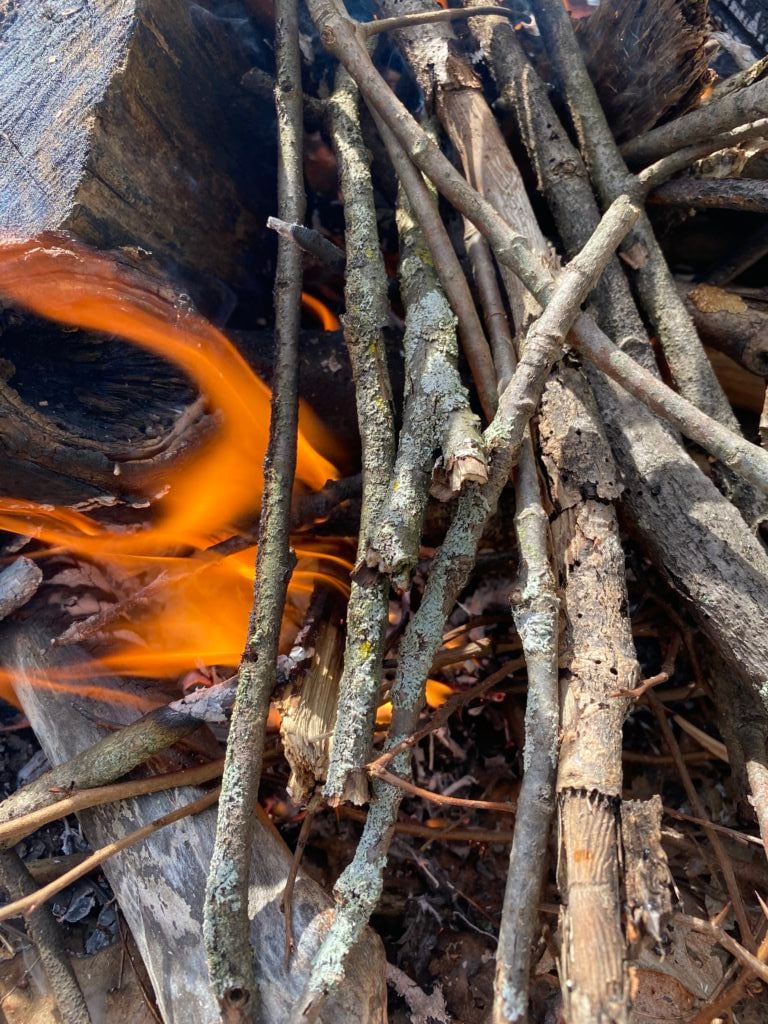
Mark Dion cooks steaks over an open fire. Photo by Mark Dion.
I grew up in Fairhaven and New Bedford, Massachusetts, the location of some of the world’s best seafood. The port is sited close to extraordinarily rich fishing grounds and New Bedford lands around 123 million pounds of fresh seafood a year. Sea scallops, scrod, lobsters, quahogs—those are my primary choices when cooking. However, I now live in rural upstate New York. It’s an area with many charms, but access to amazing sea food is not one of them.
Last week was my 12th wedding anniversary, and to celebrate with my wife, the artist Dana Sherwood, I thought I would cook a bone-in ribeye steak over the coals of a open fire.
I will never be a vegetarian (I did try when I was young), however I am deeply concerned about the well-being of the planet, so I am willing to cut down on my meat consumption—way down. A steak is now something quite special. Where I live, we can buy the meat directly from the farmer and we know a great deal about where the beef comes from and how the cattle are treated.
A Serious Steak Cooked on a Bed of Coals
First one must build a fire in a stone-lined fire pit. Cooking sausage, vegetable, and chicken for many years at the artist’s think tank and residency program, Mildred’s Lane [in Beach Lake, Pennsylvania], has given me a good deal of experience in how to build a bed of coals to cook on.
Copious amounts of dead and seasoned wood are all around my home. I don’t have to order wood or cut living trees, just do a bit of scavenging and preparation. This all takes time, but I am not cooking an everyday piece of meat: This is something ritualistic and special.
Starting a Fire:
When building a fire, it is best to start small and the add larger pieces. I save all the paper, fiber, and egg crates we generate, and use this to start the fire. It is a super fire staring material. Place twigs and then larger sticks on top tepee style, as you may have have learned in Girl Scouts or Cub Scouts. Keep feeding the fire bigger and bigger pieces of wood.
Never Cook Over Fire:
The goal is produce a bed of even hot coals. Never cook directly over flame; it will certainly burn the food.
The Bed of Coals:
In the early stages, you must tend the fire, crafting it to a good size blaze that then you can step away from and let burn down over a few hours. It is wise to check in on the fire every 20 minutes or so to make sure it is optimally burning and forming colas. With a little practice, a bright even bed of coals will form over time. Be patient and plan that this is going to take time.
The Grill:
There are lots of grills you can buy. If you are a sculptor, you can easily make one. I like the have the grill 10 to 12 inches off the coal bed. Just like with a properly seasoned skillet, I don’t over clean the grill—in fact I never clean it.
The best steak chef I know is my old friend, the artist Jason Simon. He is a true meat master. I have learned all my fine steak cookery from Jason and would always defer to his expertise. He likes a three-quarter-inch thick bone in ribeye (or porterhouse), I prefer it to be two inches thick. The meat needs a good rub down with coarse salt some hours before. We put a mild film of olive oil, pepper, and more salt on it.
Once the fire is ready and grill hot, the steak if first stood up on its bone edge, standing strait up. Hold it in this strange position for about seven minutes. I can’t really give you times for anything else. The heat is too variable and one’s taste is different. I eat my steaks extremely rare. If you cook like this over years, one develops a sense for timing. Be sure to remove the steak before you think you should, since it will still be cooking as your give it time to rest. I would not cut into it for at least ten minutes.
This is not something I do often, but as a way of marking special occasions. Of course, I am also married to cook of extraordinary talent, so I had better make certain that I am skilled in the few culinary duties I perform.
Chloe Wise first became known for her urethane “Bread Bag” sculptures, which mash up designer purses with delicious baked goods. Her work also often includes portraits of women posing with food.
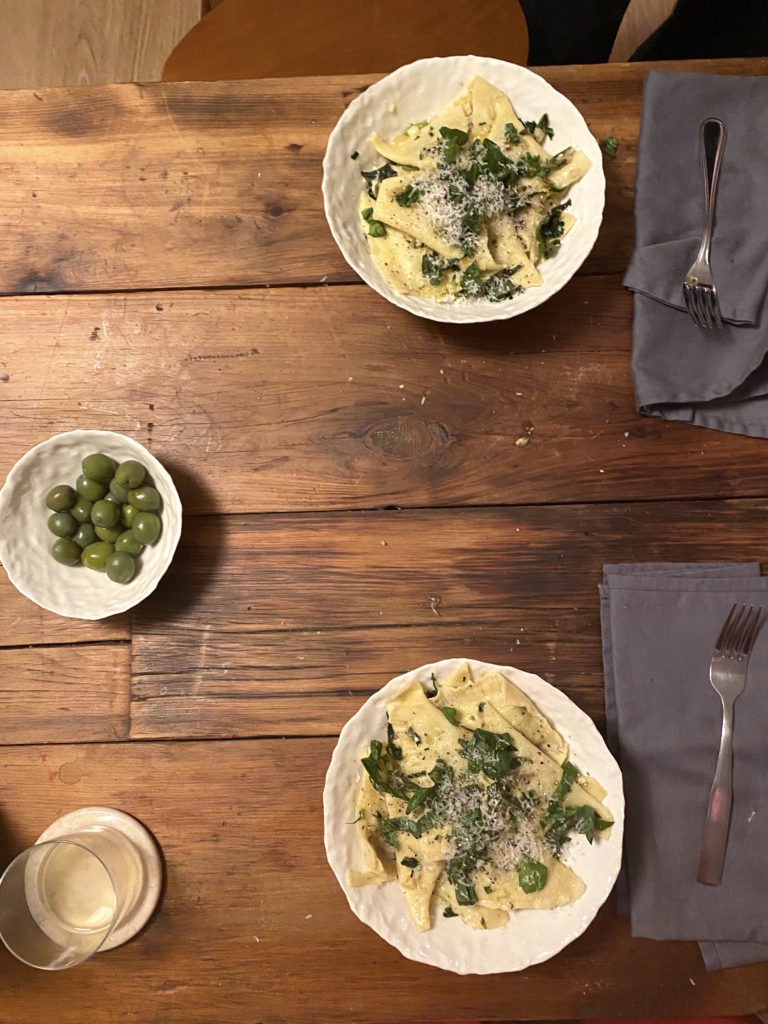
Chloe Wise’s homemade triangoli pasta. Photo courtesy of the artist.
Triangoli Pasta
Here is a sort of wing-it-triangoli pasta from scratch, with a lot of guess-work and a lot of texting [Sofia’s chef] Adam Leonti for pointers. He has cookbooks and a restaurant that is currently delivering beautiful bread and Italian food!
Start by making the pasta dough. On a clean counter, drop three eggs into two cups of flour, a teaspoon of salt, and fold and knead it into a shaggy dough. Let that sit for 30 minutes while making the filling.
Boil three bunches of spigarello (or any dark leafy green) in salty water. Drain, let cool, and wring it out, getting rid of most of the water. Then chop that up.
In a pan on medium, heat olive oil and cook two minced cloves of garlic. Add spigarello, salt, and pepper. Remove from heat, then add the spigarello mixture to a bowl with around a cup of ricotta and an egg, salt, and pepper.
Drink a bunch of natural wine and listen to the entire discography of the Zombies.
Dust the counter with semolina flour. Divide the pasta dough into sections and roll it out super thin. We didn’t have a rolling pin so we used bottles of the aforementioned wine. Text Adam Leonti and ask if you’re doing it right. Take a really long time to roll it out to desired pasta thinness, which is hard without a pasta machine, but is a nice workout, or something.
Once the dough is thin enough to see your lil fingers through it, cut the dough into squares. Get competitive with your quarantine partner at this point and see who can make a more beautiful piece-o-pasta. Add a little filling in the center of the squares, being careful not to put too much, and fold them over, closing the corners with your fingers, making handsome little triangles. You can also use a fork for crimpers edgers.
Cook those triangle guys in salty boiling water for two minutes.
Toss them in whatever you feel like. We did garlic, shallots, olive oil, more spigarello, butter, salt, pepper, Parmesan, and basil. IT WAS SO GOOD.
A New York graffiti artist known for his Wild Style lettering, Ces also makes drawings of food, like Grill ‘N Chill, his tribute to the grilled cheese sandwich.
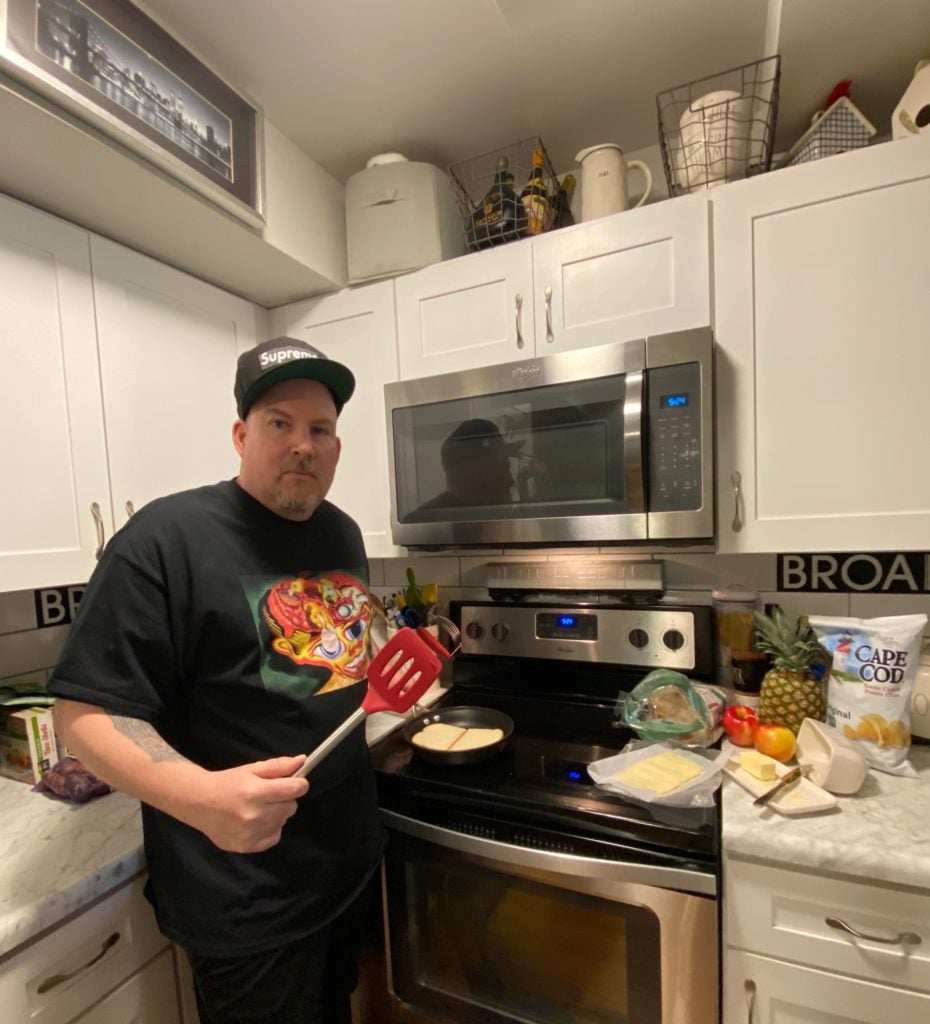
Ces making grilled cheese. Photo courtesy of Ces.
Ces No-Frills Grilled Cheese Recipe
Ingredients:
6 tbsp Land O’ Lakes Salted Butter
4 slices Pepperidge Farm Farmhouse Hearty White Bread (Levy’s Seeded Jewish Rye is another go-to!)
An abundance of freshly and thinly sliced Land O’ Lakes Yellow American Cheese (No fancy smoked Gouda here, although Muenster would be A-1.)
Instructions:
Heat a nonstick skillet over medium heat with one tablespoon.
Once butter is melted, spread 1 tablespoon butter on one side of each slice of bread (don’t be shy) and add both to the skillet, butter side down.
Add as many slices of yellow American cheese as you’d like to both sides, and cook until bread is golden and cheese starts to melt. We like extra toasty grilled cheeses in our house, so if that’s you, you may want to leave it for a minute or two longer.
Flip one piece of bread onto the other piece and let cook for 45 more seconds.
Repeat for second sandwich.
Plate and serve with a half sour pickle and some kettle cooked potato chips for the ultimate shelter in place lunch.

Ces’s drawing of his grilled cheese. Courtesy of Ces.
Shing Ying Khor has been keeping incredible illustrated food diaries during quarantine and building their own Animal Crossing contemporary art museum.
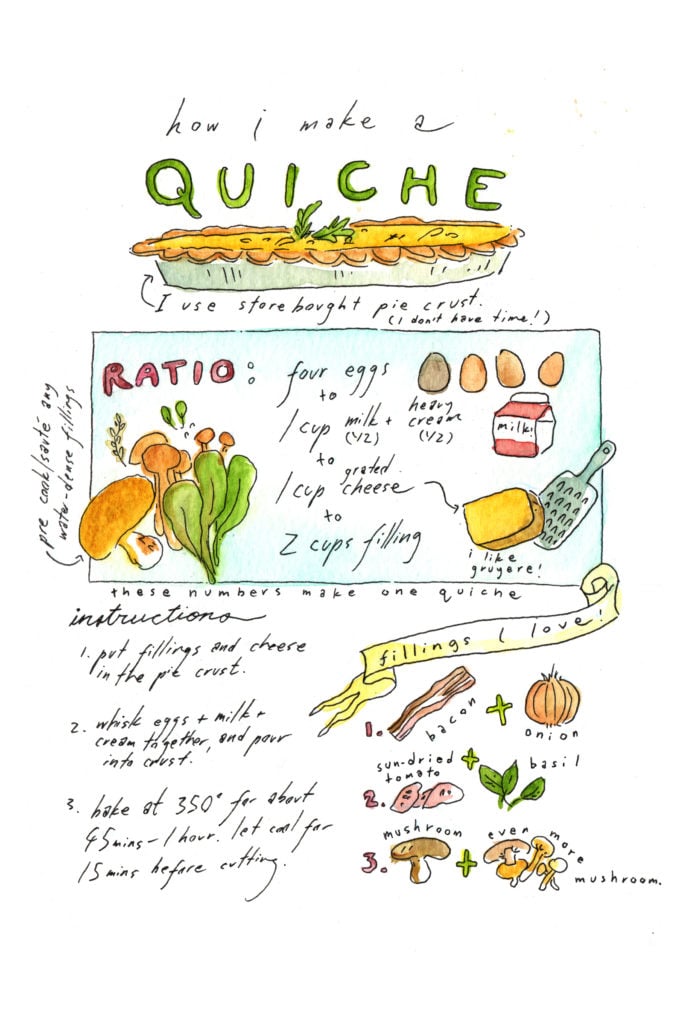
Shing Ying’s recipe for quiche. Courtesy of the artist.
In isolation, I have developed a resentment of yeast. All my bread attempts have failed, and I am surrounded by images of perfect loaves, all of which are mocking my inability to make this amalgamation of fungi do fungus things. I’ve learned to make homemade pasta, though, so that is a small joy. I like cooking, but it has become both a significant mental load and a calming presence in my life, and I don’t know how to reconcile the two yet.
I work on an annual food-centered endurance art charity project with my friend and fellow artist Eron Rauch, called Project Pizza, which raises money for a food non-profit called Food Forward. They rescue produce from farmers markets and wholesale distributors and redistributes to food banks and food kitchens. I’m thinking of how that project might be able to translate to a more online version, because so much of the joy in it is having a bunch of artist friends come over and eat homemade pizza and frantically make pizza art. I don’t even like pizza, but my lack of access to real good pizza is making me crave it.
My favorite recipes are for congee and quiche, which are less a matter of recipes than they are basic ratios, which is how I prefer to cook.
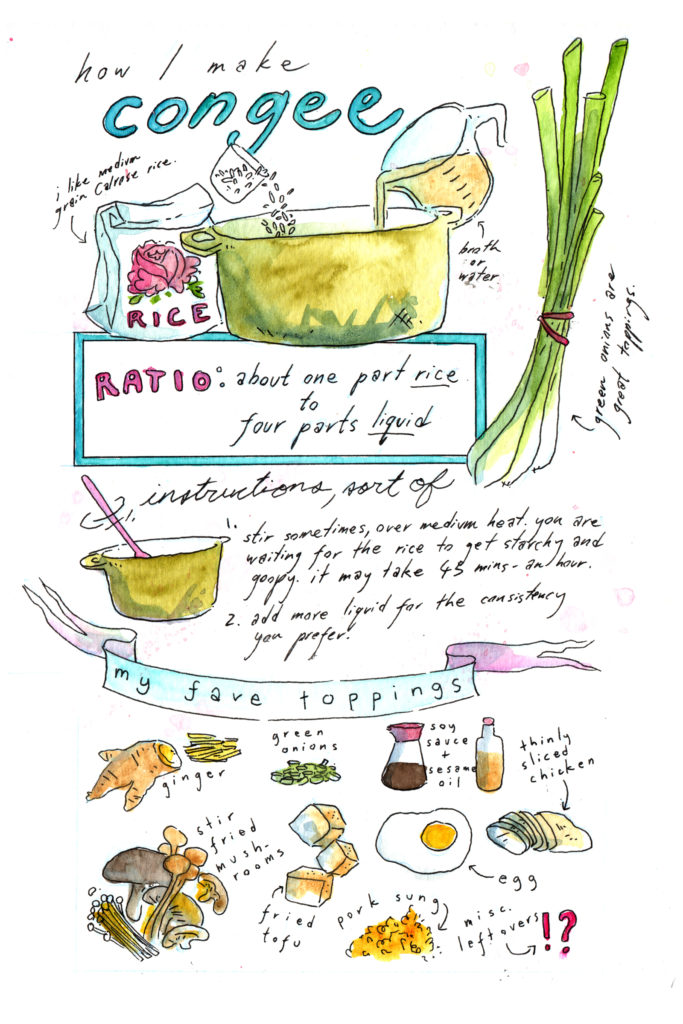
Shing Ying’s recipe for congee. Courtesy of the artist.